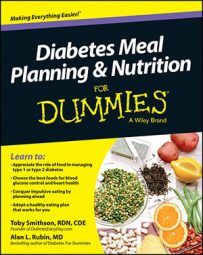Your personalized meal plan, which guides your daily choices for managing your diabetes with food, isn’t a menu, telling you exactly what to eat. Instead, it’s a framework, like a house under construction where the various rooms have been established, but leaving you a world of options for how you’re going to finish the décor. In general terms, your personalized meal plan will be based on the following criteria:
Your daily calorie requirements, which depend to some extent upon whether your health status would benefit by gaining weight, maintaining your current weight, or losing weight over time.
Your recommended carbohydrate consumption, based upon your calorie budget, your diabetes-related health status, and your medications. Usually, your daily carbohydrate recommendation is expressed as a certain number of carbohydrate, or carb, choices, which is a food portion containing approximately 15 grams of carbohydrate.
Your health status related to possible conditions, and medications for conditions, other than diabetes.
Your personal food preferences are always a consideration in developing your personalized meal plan.
Your daily calorie needs are based upon your current body mass index (BMI calculates weight for height), your activity level, your age, gender, and a goal for reaching a weight that makes sense for you. It’s no secret that most people with type 2 diabetes are overweight, and losing excess weight clearly promotes better blood glucose control.
If you fall into that group, your meal plan helps you both manage blood glucose levels and lose weight at a healthy pace. Any effective diabetes management plan also addresses prevention of the most common diabetes complications and comorbidities — related health conditions caused by diabetes, or often occurring with diabetes.
High blood pressure, high LDL cholesterol, low HDL cholesterol, and high blood triglycerides are all related, to some extent, to diet.
Your body mass index (BMI) is your mass (weight) in kilograms, divided by your height in meters squared. You can calculate your own BMI in English measures by dividing your weight in pounds by your height in inches squared, and multiplying that number by 703 to correct for using English measures.
If, for instance, you weigh 190 pounds and are 5'7" tall (67 inches) the formula is 190 / 67 x 67 = 190 / 4489 = .0423 x 703 = 29.75. A BMI higher than 25 is considered overweight, and higher than 30 is in the obese range.
Based upon your daily calorie needs, your meal plan divides those calories among the three macronutrients — protein, fat, and carbohydrate. You may expect to see the calories allotted as follows:
Calories from protein likely account for 20 percent of your daily calorie total. Each gram of protein stores 4 calories of energy. Some diabetes eating plans suggest that a higher percentage of calories come from protein, and in some cases, especially where kidney function is compromised, protein may be restricted.
Calories from fat likely account for about 30 percent of your daily calorie total. Each gram of fat stores 9 calories of energy, and your eating plan suggests that saturated fat make up only a modest percentage of your daily fat intake, with trans fat strictly limited.
Calories from carbohydrate often account for a full 50 percent of your daily calorie total. Like protein, carbohydrate stores 4 calories of energy per gram, and it’s carbohydrate that has the greatest effect by far on your blood glucose levels. For that reason, carbohydrates deserve a lot of attention, and are the main focus of your meal plan.
The key to understanding your meal plan, and to getting the benefits of following one, is learning the correct portion sizes for food. Even though your meal plan is set to provide a certain number of calories each day, you don’t have to add up calories as you go along.
Instead, with each meal you have set amounts of carbohydrate, protein, and fat, and the sum of the calories from those recommended amounts over the whole day should hit the correct calorie mark. Nobody, except maybe an accountant, likes keeping a running tally of their daily calories, so this approach is much more user friendly, and extremely effective as long as you eat the correct portions.
Portion sizes need to be specific. If someone told you the proper portion for an apple is the size of a ball, you wouldn’t know whether they meant a golf ball, baseball, basketball, or a giant beach ball. And, the difference is obviously significant.
With diabetes, knowing the correct portion sizes of carbohydrate containing foods is essential — a baseball-sized apple would be the proper size for one carb choice (15 grams of carbohydrate), but only 1 tablespoon of maple syrup would give you the same amount of carbohydrate. In general, both portions have the same effect on blood glucose.
It’s not necessary to learn every portion size of every food. The best strategy is to learn the correct portion size of the foods you most commonly eat, and refer to a carb counting book or an exchange list for foods you haven’t memorized.
Be aware that you probably have a natural resistance to thinking too much about food — it just seems that eating shouldn’t require any thinking. Unfortunately, you need to get beyond that barrier if you intend to take control of your health — thinking about food is required. And not just for carbohydrates.
Even though carbohydrates have the most direct impact on blood glucose, dietary fat contributes to excess body weight by piling on calories, and saturated fats contribute to unhealthy cholesterol and triglyceride levels. Your personalized meal plan, however, accounts for all of these issues, and minimizes the amount of thinking and calculating you have to do.
Blood glucose control is very important and must be a clear focus of your meal plan. But, for most people with diabetes the greatest threat to well-being is heart disease. Because diabetes increases your risk, it’s as important to concentrate on an eating plan that’s heart healthy, too.

